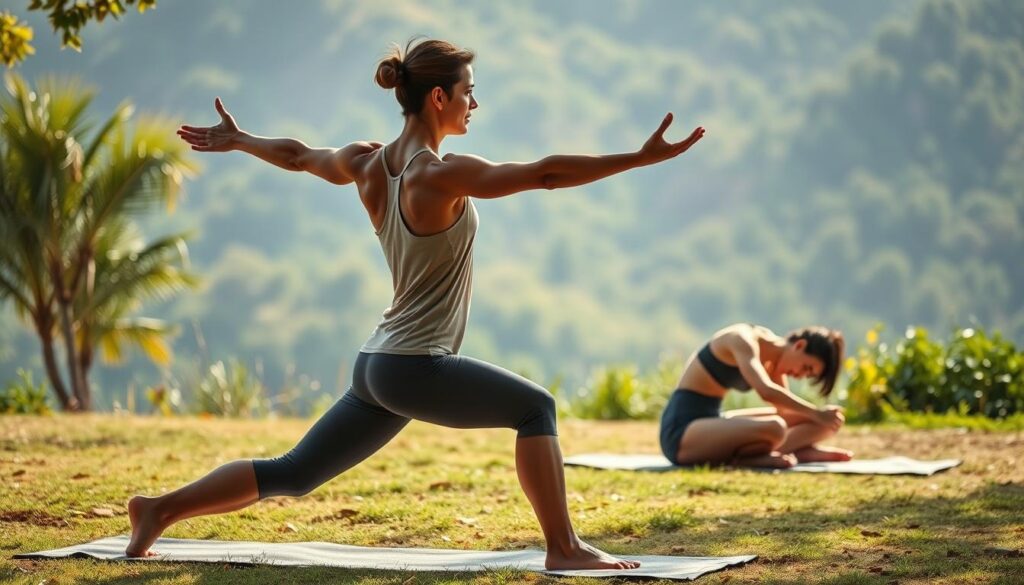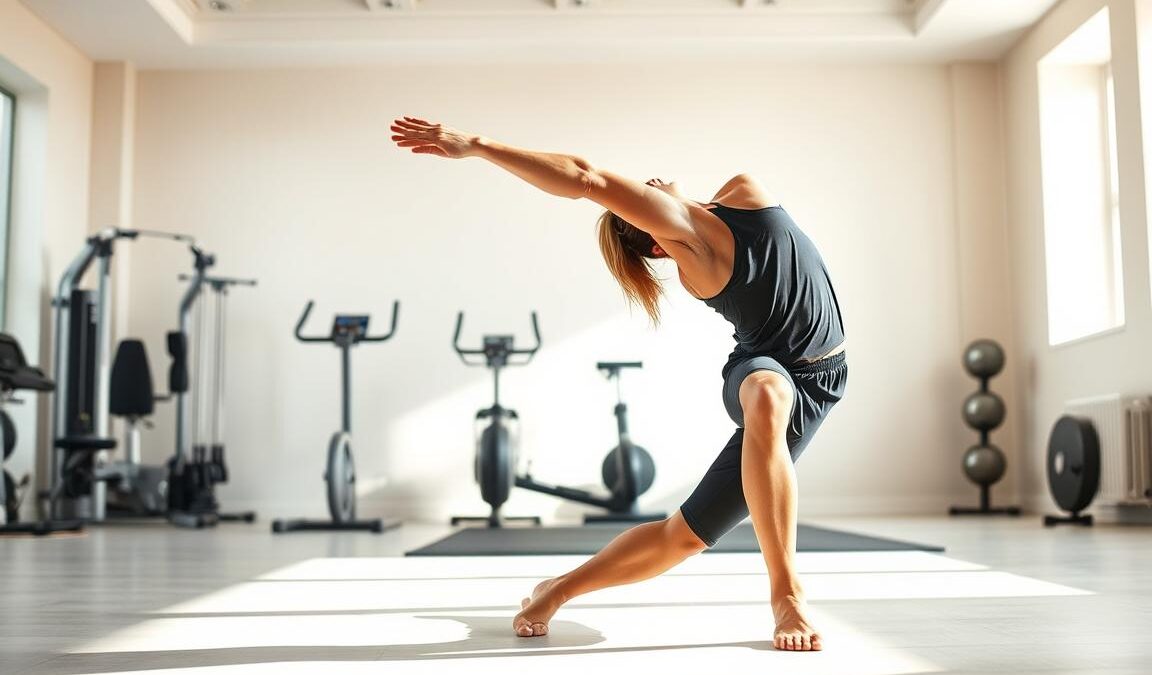
Flexibility-First Workout Plan to Improve Mobility
Are you looking for a way to boost your mobility and overall health? A flexibility-first workout plan might be what you need. It’s more than just stretching. It uses special techniques to improve how well you can move, helping you avoid injuries.
Adding simple yet powerful flexibility exercises to your day can make a big difference. It doesn’t matter if you’re just starting out or already active. This plan can change how you move for the better!
Understanding Mobility and Its Importance
Mobility is about how well your body can move. Without good mobility, simple tasks like dressing or walking up stairs can be hard. It’s key to living a good life.
Mobility training boosts your range of motion and blood flow. It helps your joints work better, making physical tasks easier. Experts say it’s good for everyone, from athletes to regular people.
Regular mobility training keeps your joints healthy and lowers injury risk. It helps you stay active and do things with ease and confidence.
Defining Flexibility and How It Relates to Mobility
Flexibility is about how well your body can move into certain positions. It lets your joints and muscles move more, helping you function better. Many people talk about the difference between flexibility and mobility, showing how they’re connected.
Mobility, on the other hand, is about moving in a way that needs strength and control. It lets you move through different ranges of motion, using more than just the muscles for flexibility. When you’re more flexible, you can move better, making everyday tasks easier.
Adding both flexibility and mobility to your workouts is key for a balanced fitness routine. Knowing how they work together helps you pick exercises that boost both. This can lower your chance of getting hurt and improve how well you do in physical activities.
Benefits of a Flexibility-First Workout Plan
Starting with flexibility in your workouts has many benefits. It helps you move better, which is key for daily tasks and sports. This way, you can do more without getting hurt.
Flexibility training also helps prevent injuries. It makes your muscles and joints stronger. This means they work better under stress, lowering the chance of injuries.
Another plus is better joint health. This leads to healthier joints and helps them last longer. A flexible body makes everyday activities easier and more comfortable.
You don’t need to spend a lot of time on flexibility training. Just a few minutes each day can make a big difference. Adding simple stretches to your day can greatly improve your flexibility.
Key Principles of Mobility Training
Learning the key principles of mobility training can really boost your workouts and health. These include being consistent, facing new challenges, and practicing often. Adding these to your routine will make you perform better and be more flexible.
“Greasing the groove” is a great way to follow these principles. It means doing flexibility exercises often, either as part of your main workout or in short daily sessions. Being consistent is key to lasting success.
To see real progress, try intense stretching two to three times a week. It’s important to balance hard workouts with rest. This way, you care for your muscles and joints, helping them get better with time.
Following these mobility training principles will guide you to success. For more tips and exercises, check out this detailed guide on mobility training fundamentals to take your workouts to the next level
Flexibility-First Workout Plan: An Overview
Creating a successful flexibility-first workout plan is all about knowing what to include. It’s important to mix in dynamic movements for better flexibility. These movements work many muscles at once, improving your flexibility and mobility.
Incorporating Dynamic Movements
Dynamic movements are essential in a flexibility-first workout. Leg swings, walking lunges, and arm circles boost blood flow and prepare muscles and joints for stretching. Adding these to your warm-up increases your range of motion. Try different movements to cover all parts of your body for a balanced workout.
Importance of Consistency
Sticking to a flexibility routine is vital for seeing results. Whether it’s a dedicated session or daily stretching, regular practice is key. Doing flexibility exercises often helps improve your range of motion and overall health. Make sure to set aside time for these exercises to see the benefits.

| Dynamic Movement | Benefits | Recommended Frequency |
|---|---|---|
| Leg Swings | Improves hip flexibility | Daily |
| Walking Lunges | Enhances lower body mobility | 3-4 times per week |
| Arm Circles | Increases shoulder flexibility | Daily |
| High Knees | Engages core and warms up lower body | 3-4 times per week |
Daily Mobility Routines to Enhance Flexibility
Adding daily mobility routines to your life can greatly improve your flexibility and health. Starting your day with a quick routine boosts energy and improves blood flow. It also helps you feel ready to tackle the day.
In the evening, stretching helps relax your muscles and aids in recovery. This leaves you feeling refreshed for the next day.
Quick Morning Mobility Routine
Start your day with exercises that wake up your body and mind. Here’s a simple routine:
- Neck Rolls: 5 repetitions each way
- Shoulder Shrugs: 10 repetitions
- Standing Side Stretch: Hold for 15 seconds each side
- Hip Circles: 5 repetitions in each direction
- Leg Swings: 10 repetitions per leg
Evening Stretching Techniques
After a long day, stretching can help ease tension and prepare for sleep. Try these stretches in your evening routine:
- Child’s Pose: Hold for 30 seconds
- Seated Forward Bend: Hold for 30 seconds
- Figure-Four Stretch: Hold for 30 seconds per leg
- Cat-Cow Stretch: Perform for 1 minute
- Supine Twist: Hold for 30 seconds per side
Both morning and evening routines improve flexibility over time. Regular practice boosts physical ability and makes daily activities easier. Make these routines a part of your life for a more flexible body and better daily mobility.
Top Mobility Exercises to Include in Your Routine
Adding the best mobility exercises to your routine can boost your flexibility and movement quality. Here are some mobility workout suggestions that target key muscle groups. They offer a balanced approach to improving your mobility.
World’s Greatest Stretch
The world’s greatest stretch works on several muscle groups at once. Start in a lunge, with your hands on the floor beside your foot. Move your front elbow down, then open your chest and arm up towards the sky.
This stretch enhances flexibility in your hips, hamstrings, and thoracic spine. It’s a key part of any good mobility routine.
Cat-Cow Stretch
The Cat-Cow stretch is great for your spine’s mobility. Start on all fours, with your wrists under your shoulders and knees under your hips. Inhale and arch your back, lifting your gaze.
Exhale and round your back, tucking your chin. This flow boosts your spine’s flexibility and mobility.
90/90 Hip Switch
The 90/90 hip switch is excellent for hip flexibility. Sit with one leg bent in front at 90 degrees and the other behind you at 90 degrees. Switch your legs, keeping the angles the same.
This movement opens your hips and increases your range of motion. It’s a great addition to your daily mobility workout.
Adjusting Your Flexibility-First Workout Plan for All Levels
Flexibility training is key for better mobility. When starting your flexibility workout, remember to make changes as needed. Everyone’s fitness level is different, so it’s important to tailor your approach.
Beginners should start with simple stretches and basic movements. Try forward bends and seated stretches to ease into it. Always listen to your body and take time to recover. As you get more comfortable, you can add more challenging exercises.
For those who are more experienced, you can try more advanced stretches. Add dynamic stretches and high-intensity workouts to push your limits. It’s important to keep changing your routine to avoid getting stuck and to stay motivated. Make sure your workout plan includes a variety of exercises to meet your goals.
Here’s a quick guide to help you understand:
| Fitness Level | Focus Area | Suggested Moves |
|---|---|---|
| Beginner | Basic Flexibility | Forward Bends, Seated Stretches, Gentle Twists |
| Intermediate | Endurance and Range | Standing Stretches, Dynamic Lunges, Hip Openers |
| Advanced | Intensity and Control | Dynamic Flows, PNF Stretching, Advanced Yoga Poses |
No matter your fitness level, these tips help you grow and enjoy flexibility training. It makes sure everyone can benefit and have fun.
Tracking Progress and Making Adjustments
To reach your mobility goals, tracking your progress is key. One great way is to use video recordings of your workouts. This lets you see how far you’ve come visually.
Keeping a workout journal is also helpful. Write down your exercises and how you feel during them. This helps you see which workouts work best and if you need to change your routine.
Working with a fitness trainer can also be very helpful. They can look at how you move, point out what needs work, and suggest changes just for you. Their advice helps you stay on track and improve faster.
Staying Motivated in Your Flexibility Journey
Keeping up motivation for flexibility training is key to reaching your mobility goals. Start by setting goals that are realistic and achievable. For example, aim to increase your range of motion by a certain percentage each month. This way, you focus on gradual improvement, making it feel more reachable.
Having a workout partner can greatly help in staying on track with your flexibility goals. Working out with someone who has similar goals adds a sense of accountability and makes it more fun. You can share new exercise ideas or celebrate each other’s small wins. Every step forward is important!
Lastly, using different ways to stay motivated, like tracking your progress or making a vision board, can keep you excited. Celebrate your small achievements and change up your routines to avoid getting bored. These strategies not only improve your mobility but also strengthen your commitment to this journey.



